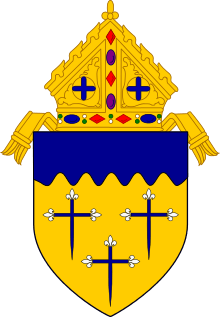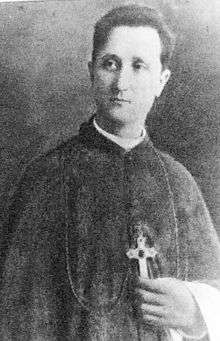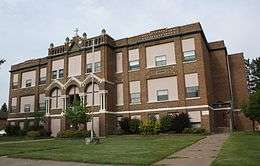Roman Catholic Diocese of Superior
| Diocese of Superior Dioecesis Superiorensis | |
|---|---|
 | |
| Location | |
| Country | United States |
| Territory | 16 counties in northwestern Wisconsin |
| Ecclesiastical province | Milwaukee |
| Statistics | |
| Area | 15,715 sq mi (40,700 km2) |
| Population - Total - Catholics |
(as of 2010) 458,000 78,826 (17.2%) |
| Parishes | 105 |
| Information | |
| Denomination | Roman Catholic |
| Rite | Roman Rite |
| Established | May 3, 1905 (111 years ago) |
| Cathedral | Cathedral of Christ the King |
| Patron saint | St. Augustine of Hippo |
| Current leadership | |
| Pope | Francis |
| Bishop | James Patrick Powers |
| Map | |
_map_1.jpg) | |
| Website | |
| www.catholicdos.org | |
The Roman Catholic Diocese of Superior (Latin: Dioecesis Superiorensis) encompasses the city of Superior and the counties of Ashland, Barron, Bayfield, Burnett, Douglas, Iron, Lincoln, Oneida, Price, Polk, Rusk, Sawyer, St. Croix, Taylor, Vilas, and Washburn in northern Wisconsin, with an area of 15,715 square miles (40,700 km2). Its episcopal see is Superior, and the Cathedral of Christ the King in Superior is its mother church. It is a suffragan diocese of the Archdiocese of Milwaukee.
History
The diocese was established on May 3, 1905 by Pope Pius X.[1] It was created from the northern part of the Diocese of La Crosse and the northwestern part of the Diocese of Green Bay, with Augustine Francis Schinner as the first bishop.[2][3]
Prior to the official founding of the diocese in 1905, there had already been a rich history of Catholicism in the region. Centuries earlier, Catholic missionaries had forged a dynamic presence throughout the Lake Superior region of Wisconsin.[4]
The early history of Catholicism in the state of Wisconsin started within the territory that the Diocese of Superior now encompasses, with the arrival of Father René Menard in 1661.[4] Fr. Menard was a Jesuit missionary who came to North America to evangelize the Native American population, and was fluent in the Ojibwe, Odawa, and Huron dialects. After spending the winter of 1660-1661 in the Upper Peninsula of Michigan, some historical accounts have Fr. Menard venturing in the spring of 1661 to Chequamegon Bay, near Ashland.[4] Although his time there was short, he cleared the path for fellow Jesuits who followed him.
In 1665, Fr. Claude Allouez started a Catholic mission near Chequamegon Bay, and named it the Mission of the Holy Ghost.[4] The exact location of the mission remains a mystery, although historians have speculated it was located at La Pointe, on Madeline Island. Historically, Madeline Island was a spiritual center for the Lake Superior Chippewa.
In 1669, Fr. Jacques Marquette arrived at the Mission of the Holy Ghost, upon the departure of Fr. Allouez to the Fox River Valley. Fr. Marquette found success in his work among the native people, and baptized over 1,000 converts.[4]
During this time, the region was being overseen by French Catholic leaders in Quebec, which became a diocese in 1674, encompassing all of North America east of the Mississippi River. In 1791, the region was transferred to the Diocese of Baltimore, which was the first Catholic diocese created in the then-newly formed United States.[4]
In 1843, the Diocese of Milwaukee was established, and consisted of the entire state of Wisconsin. Northern Wisconsin remained within the Diocese of Milwaukee, until the formation of the Diocese of Lacrosse, and the Diocese of Green Bay, which then served the northern region.[4] Finally, in 1905, the Diocese of Superior was created by Pope Pius X, encompassing 16 counties in northern Wisconsin.[1]
The oldest Catholic congregation in the state of Wisconsin (in continuous operation to the present-day) is within the Diocese of Superior. On July 27, 1836, Fr. Frederic Baraga arrived at La Pointe, and immediately set to work, building a log church.[4] Fr. Baraga, like the Jesuit missionaries before him, had success evangelizing the native people. His congregation at La Pointe grew, and also included many early European immigrants, primarily French Fur Traders. In 1838, Fr. Baraga built a larger church at La Pointe, on the spot of the present-day location of St. Joseph's Catholic Church.[4]
The first Bishop to serve the Diocese of Superior was Augustine Francis Schinner, who was consecrated as Bishop on July 25, 1905.[4] Bishop Schinner faced many challenges, as the head of the new diocese, including the need to recruit priests to serve the growing number of parishes throughout the diocese. By the time Bishop Schinner resigned as the bishop of Superior in 1913, he saw the pool of priests grow from 39 diocesan priests in 1905 to 62 in 1913.[4]
Today, there are now 105 parishes within the Diocese of Superior.
Bishops

The following is a list of the Roman Catholic Bishops of the Diocese of Superior and their years of service:
-
 Augustine Francis Schinner (1905–1913)
Augustine Francis Schinner (1905–1913) -
 Joseph Maria Koudelka (1913–1921)
Joseph Maria Koudelka (1913–1921) -
 Joseph G. Pinten (1922–1926)
Joseph G. Pinten (1922–1926) -
 Theodore H. Reverman (1926–1941)
Theodore H. Reverman (1926–1941) -
 William Patrick O'Connor (1942–1946)
William Patrick O'Connor (1942–1946) -
 Albert Gregory Meyer (1946–1953)
Albert Gregory Meyer (1946–1953) -
 Joseph John Annabring (1954–1959)
Joseph John Annabring (1954–1959) -
 George Albert Hammes (1960–1985)
George Albert Hammes (1960–1985) -
 Raphael Michael Fliss (1985–2007)
Raphael Michael Fliss (1985–2007) - Peter F. Christensen (2007–2014)
- James Patrick Powers (2016– )
-
 = Deceased
= Deceased
-
Media
- The Diocese of Superior publishes a bi-weekly newspaper, The Superior Catholic Herald, which was founded in 1953. There are approximately 12,000 subscribers and an estimated readership of more than 36,000.[5]
- Real Presence Radio (WWEN-FM), broadcasts from Wentworth, Wisconsin, and serves the Duluth-Superior area. Real Presence Radio is a Catholic talk radio network based in Grand Forks, North Dakota. The network also carries some programming from the national EWTN Radio network.[6]
- Holy Family Radio (WWMD-LP), a 100-watt station, broadcasts from Ashland on 95.5 FM. The station is an affiliate of Relevant Radio, a Catholic Radio network based in Green Bay.[7] Holy Family Educational Association, Inc. manages the station, which has been on the air since 2007 and reaches the Ashland and Washburn area.[8]
Demographics
The Diocese of Superior has a membership of 73,638 Catholics in 105 parishes.[9] Eight of those parishes stand as single parish units, and 96 parishes have been combined to form 34 clusters. There are 46 priests and 65 permanent deacons.[9]
Within the diocese, there are 15 elementary schools, but no high schools or seminaries. There are 74 Catholic cemeteries.
Catholic schools
The Diocese of Superior operates 15 elementary schools, with a combined total of over 2,000 students.[10] Catholic schools operate in the following communities:

- Ashland - Our Lady of the Lake School
- Hudson - St. Patrick School
- Ladysmith - Our Lady of Sorrows School
- Medford - Holy Rosary School
- Merrill - St. Francis Xavier School
- New Richmond - St. Mary School
- Park Falls - St. Anthony of Padua School
- Reserve - St. Francis Solanus School
- Rhinelander - Nativity of Our Lord School
- Rice Lake - St. Joseph School
- River Falls - St. Bridget School
- Somerset - St. Anne School
- Spooner - St. Francis de Sales School
- Superior - Cathedral School
- Tomahawk - St. Mary School
See also
| Wikisource has the text of the 1913 Catholic Encyclopedia article Diocese of Superior. |
- List of the Catholic dioceses of the United States
- List of Roman Catholic dioceses (alphabetical)
- List of Roman Catholic dioceses (structured view)
References
- 1 2 Blied, Rev. Benjamin J. (1980). St. John the Baptist Congregation. p. 62.
- ↑ "Diocese of Superior". Catholic-Hierarchy. Retrieved 2014-04-16.
- ↑ "Diocese of Superior". Gcatholic.org. Retrieved 2014-04-16.
- 1 2 3 4 5 6 7 8 9 10 11 Our Journey Through Faith: A History of the Diocese of Superior. Booklink. pp. 11–15.
- ↑ Superior Catholic Herald, About Us
- ↑ Streaming Radio Guide-WWEN-FM
- ↑ "Catholic Communities of the Ashland Cluster Bulletin" (January 17, 2016). Catholic Communities of the Ashland Cluster.
- ↑ "WWMD-LP". WWMD-LP Website. Retrieved 2 February 2016.
- 1 2 "http://cathoDiocese of Superior - Statistics". Retrieved 7 May 2016.
- ↑ "Diocese of Superior-Schools". Retrieved 7 May 2016.
External links
| Wikimedia Commons has media related to Roman Catholic Diocese of Superior. |
- Roman Catholic Diocese of Superior Official Site
- History of the Catholic Diocese of Superior, Wisconsin
- Christ the King Cathedral
- Superior Catholic Herald newspaper
Arms
 |
The crosses further commemorate the edict of King Charles V in 1376, when he reduced the number of fleur-de-lis in the French coat-of-arms to three in honor of the Three Divine Persons. The blue waters of Lake Superior are indicated across the top of the shield by the wavy blue lines of the "chief" or upper partition. |
Coordinates: 46°42′25″N 92°05′07″W / 46.70694°N 92.08528°W